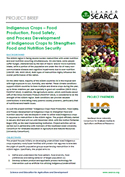Indigenous Crops – Food Production, Food Safety and Process Development of Indigenous Crops to Strengthen Food and Nutrition Security
Background
 The Southeast Asian Region is facing the double burden of malnutrition, with under-nutrition and over-nutrition occurring simultaneously. On one hand, some people suffer from hunger, characterized by the lack of macro- and micro-nutrient intake, while a portion of the population are under the risk of many non-communicable diseases and cognitive impairments due to over-nutrition (UNICEF, WB, WHO 2014). Both types of malnutrition highly influence the overall performance of a nation.
The Southeast Asian Region is facing the double burden of malnutrition, with under-nutrition and over-nutrition occurring simultaneously. On one hand, some people suffer from hunger, characterized by the lack of macro- and micro-nutrient intake, while a portion of the population are under the risk of many non-communicable diseases and cognitive impairments due to over-nutrition (UNICEF, WB, WHO 2014). Both types of malnutrition highly influence the overall performance of a nation.
On the other hand, majority of Southeast Asian countries lie in the tropical belt with high exposure to sun, humidity, and rainfall. These climate conditions support Southeast Asian countries to have multiple and diverse crops during the year, up to three rotations per year especially in good soil condition (OECD 2012; FAOSTAT 2014). In addition, the agriculture sector, which contributes about 18% of the Gross Domestic Product (FAOSTAT 2014), is the strength of the Southeast Asian region. Both conditions can provide valuable contributions in alleviating many polemic society problems, particularly that of nutritional and health issues.
As such, the project entitled "Indigenous Crops – Food Production, Food Safety and Process Development of Indigenous Crops to Strengthen Food and Nutrition Security" was developed in order to utilize local crops in response to malnutrition in the Southeast Asian region. The project officially started in February 2016 and will run until December 2017, with the Institut Pertanian Bogor (IPB) as the lead implementing institution. Project activities are being carried out in partnership with members of the Southeast Asian University Consortium for Graduate Education in Agriculture and Natural Resources (University Consortium).
Objectives
The project aims to develop underutilized local and indigenous crops especially roots and tubers fortified with protein-rich legumes to alleviate the plight of specific population groups experiencing malnutrition in the Southeast Asian region. Specifically, the project aims to:
- Define and understand the food pattern, food diversity, food preferences, and eating behavior of the target population(s);
- Develop a suitable product and applicable process technology for intervention such as artificial rice, utilizing indigenous and underutilized root or tuber crops fortified with additional nutritional requirements such as legume-derived proteins;
- Examine the impact of intervention products in alleviating nutritional concerns in target population(s); and
- Examine the implementation of replicating such applicable process technology in other regions (amongst the ASEAN Member States).
Methodology
Activity 1: Consumer Research: Survey food pattern, food diversity, food preferences, and eating behavior of target population.
- National picture of food, nutrition, and health in Indonesia
- Food safety aspect of non-rice indigenous staple food
- Profile of household food security
- Shifting consumption on staple food
- Food consumption pattern among three generations
- Plausible reason behind the shifting of staple food consumption
- Opportunity of development of non-rice indigenous staple food product in strengthening food security and alleviating the risk of non-communicable diseases
Activity 2: Intervention Product Development
- Development of artificial rice
- Development of indigenous starch noodles
- Consumer preference evaluation
- Analysis of potential functionality for metabolic syndrome
Activity 3: Intervention study: Artificial rice and noodles made from sweet potato and fortified with indigenous legumes will be put on trial to alleviate malnutrition in target populations. Parameters to be measured include anthropometric health parameters including blood glucose level assessment, as well as indirect results such as economic welfare change, as an indicator of productivity.
Activity 4: Process technology replication study: In the effort to address similarly defined target population in various regions of ASEAN, the process technology to develop and produce artificial rice need to be feasibly applied and implemented.
Expected Outputs
Activity 1 – (i) Critical Information on food pattern, food diversity, food preferences, and eating behavior of target population; (ii) Information and data analysis of general and/or specific nutrient requirements of target population; and (iii) Identification of pilot testing area/target demographic;
Activity 2 – (i) Process technology (including formulation) to produce artificial rice fulfilling nutritional requirements for intervention; (ii) Intervention product data on nutritional, safety, and sensory characteristics; (iii) Optimized process technology; (iv) one scientific article for publication; and (iv) intellectual property/patent;
Activity 3 – (i) Data on intervention effectiveness; and (ii) one scientific article for publication;
Activity 4 – (i) Data on process technology replication viability.